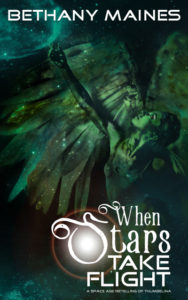The Shape of Tales
/in Galactic Dreams, General Writing, The Stiletto GangLast year two other authors and banded together to invent GalacticDreams—a shared sci-fi universe for novellas based on fairy tales. As I mentioned in a blog at the time I was shocked to go through the fairy tales and realize how full horrible things they really were. The shock only deepened when I learned that these were the sanitized versions. Apparently, the Grimm brothers put out a first edition and found out that they were a little too gory and horrible for even their 1800’s audiences. So they switched some of the baddies to step-parents (instead of full parents) and pulled out some of the most egregious elements and put out a new edition that is more similar to the stories we’re familiar with today. However, as the shock of cannibalism, incest, and limb removal wore off, I began to notice another strange thing about the stories: they don’t make sense.
The story I’m using this year for my sci-fi novel The Seventh Swan is based on the story of the Six Swans. The story involves at least 2 witches, 2 kings, and 3 queens and not one of them has a name. But you won’t need to worry about which is which because they never interact. The witch at the start of the story disappears after she’s set events in motion. Ditto to the evil queen witch step-mother. The doting father of the swan brother and heroine puts them in a tower to protect them from the evil queen witch step-mother, but when his daughter says “Dad your wife turned my brothers into swans.” He’s all “Nah, she wouldn’t do that.” And the story is called the Six Swans, so clearly it must be about the brothers, right? No. They show up once and disappear again until the end. And then the heroine, now sworn to silence to save her brothers (and how did they know that was what had to happen to save them?) gets married has not one, but three children, and her mother-in-law steals them and accuses her of eating them. Because… that was so common that people would buy that story? Eventually, (after the third baby) the husband’s like “I guess she’s a cannibal” and he decides to burn her at the stake. But fortunately the six years of silence is up and she saves the brothers and avoids the stake.
None of that makes sense. However, the story still makes sense. A girl must save her brothers from an evil curse by suffering in silence and setting herself to a menial task. The flow of the story works, but the actual events and characters are insane. And in fairy tale after fairy tale the same holds true. Characters pop up and then disappear. Characters contradict their own statements. Random events occur. But they all move the story toward the mandated happy ending. Fairy tales are not a lesson in how to write beautiful descriptions or develop fully fleshed out characters, but they have been an amazing lesson in how stories function and how much a reader will forgive to get to the happy ending.
OK, Not OK?
/in Galactic Dreams, General WritingHappy Valentines Day! Who doesn’t like to celebrate the bloody death of man in third century Rome? I, for one, am all about the guy that no one really knows why he died, or how, but heck, if he somehow wants to spawn a greeting card industry associated with romantic and courtly love then I’m all for it. I am so for it, in fact, that I have written a book for the occasion – When Stars Take Flight!
 When Stars Take Flight, a retelling of Thumbelina, is part of the new Galactic Dreams collection from Blue Zephyr Press featuring fairy tales retold as science fiction adventures. Each story is unique, but all the stories take place in the same universe. Galactic Dreams Volume 1 also includes Soldier, Princess, Rebel Spy (inspired by Mulan) by Karen Harris Tully and Aurora One (Sleeping Beauty) by the Stiletto Gang’s own J. M. Phillippe.
When Stars Take Flight, a retelling of Thumbelina, is part of the new Galactic Dreams collection from Blue Zephyr Press featuring fairy tales retold as science fiction adventures. Each story is unique, but all the stories take place in the same universe. Galactic Dreams Volume 1 also includes Soldier, Princess, Rebel Spy (inspired by Mulan) by Karen Harris Tully and Aurora One (Sleeping Beauty) by the Stiletto Gang’s own J. M. Phillippe.
Writing this book was a fascinating process involving a lot of “research” aka reading of fairy tales. And the first thing I have to say is what the hell is wrong with fairy tales? What sick twisted bastard invented these things? So much limb chopping, incest, and cannibalism. Apparently, cannibalism was a far greater problem back in the old days than I gave it credit for. The second part of the process was the “world building”. The other authors and I had to establish, build and agree upon our science-fiction setting. Monetary systems, space travel, religions—just how do all of these things function in our universe? As we developed rules, we created some artificial stumbling blocks for ourselves to push how we were writing. One rule was that only people directly from Earth would use the word OK. Until I couldn’t use it, I had no idea how often I used OK. But there is no word more distinctly American than OK. Would space colonists who were originally from Iceland use the word OK five hundred years or a thousand years from now? It seems unlikely. But even with that in mind, I ended up having to do a find and replace in my manuscript to find all the places I typed it without even thinking about it. I believe that the result of our hard work are a fun, romantic, adventurous stories that stays true to the fairy tale tradition (I mean the ones about torture and true love, we skipped the cannibalism), but creates something entirely new and unique. I’m excited by this collection and hope that other people (aka readers) are too.

Buy now – three sci-fairy tale novels for $4.99!
Welcome to the universe of Galactic Dreams, where fairy tales are reimagined for a new age—the future. In each Galactic Dreams novella you’ll find an old tale reborn with a mixture of romance, technology, aliens and adventure. But beware, a perilous quest awaits behind every star and getting home again will depend on a good spaceship, true love, and maybe just a hint of magic.
Buy now – three sci-fairy tale novels for $4.99!
